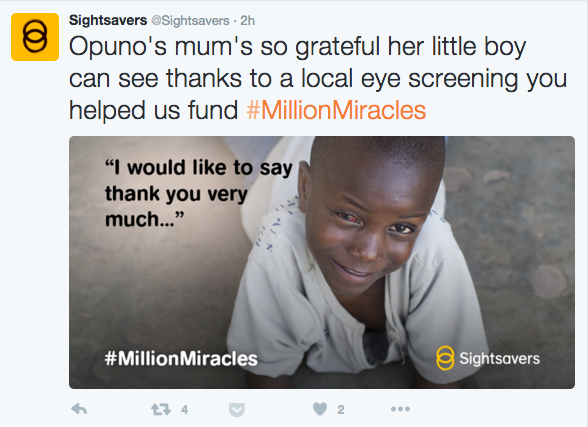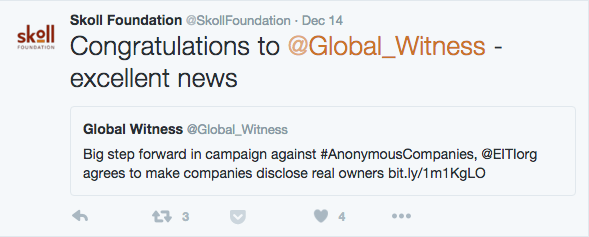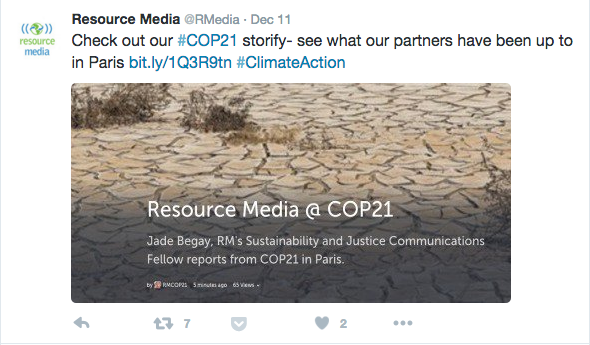A How-To Guide For Nonprofits
For Part I of this two-part series, click here
Part 2: Develop Your Twitter Strategy
You’ve created a profile with a robust bio and stirring visuals, and now you know the lingo. It’s time to think about what you want to accomplish.
Step 1: Identify your goals. Organizations use Twitter differently. Some set out to build thought leadership and engage community. Others seek donors and volunteers, promoting their fundraising campaigns, educating followers, and calling supporters to action.
Step 2: Identify your target audience. Who are you trying to reach and why? The answer to this question will determine the content you post and the way you use Twitter to tell your organization’s story.
Step 3: Evaluate your resources. It may take some time to decide how exactly Twitter fits into your overall organizational strategy. But in the meantime, it helps to be able to answer a few key questions:
Who will be in charge of your organization’s Twitter? Will there be one voice or many? How much time can you realistically devote to Twitter? Will you spend that time researching, building your follower base, or engaging in conversation? Is there going to be an approval process for new Tweets? (Many of these questions come from a great post at Echo & Co.)
Once you evaluate the energy and resources your organization has, you can begin to forge a Twitter strategy around that.
Part 3: Produce Quality Content
Regardless of your goals, a successful Twitter is one that gains followers. And the only surefire way to get people to follow you is to produce content that is interesting, retweetable, and consistent.

Twitter can be informal, casual, and fun! Would you want to watch this?
Step 1: Begin creating content. Make your Twitter timeline a place that your followers want to visit for information, for inspiration, and for content that only you can offer. Tweet about things that are newsworthy. Tweet about what matters to your supporters. If you can’t answer the question, “Would I want to read these Tweets and click on their embedded links?” with an affirmative, it needs some work.
There are various theories about the type of content one should produce, but the general consensus is that it should be a combination of content from others (Retweets, links), your own content (blogs, updates, links to information or articles on your website), and calls to action (fundraising, calls for volunteers).

Retweets are a great way to populate your Twitter timeline.
Step 2: Craft engaging Tweets. With only 140 characters to work with, taking the time to format an easy to read, simple tweet with a link, image, or video can make all the difference. And research shows that you can increase engagement with a few simple tricks.
Insert image links. Tweets with image links are 2x as likely to be retweeted. So be sure to adorn your timeline with compelling photos that make your followers want to click on the links they illustrate. Use an image of your own, grab one from a Creative Commons site like Flickr, or create a meme with a tool like Canva or PicMonkey. Before you upload your images, you can format them, although photos can now be viewed in any size on Twitter.com.
Keep it short and sweet. Tweets between 120 and 130 characters get the most engagement. Make your Tweets short enough that someone can Retweet and add their own comment. Stop your links from taking up too much space with free url shorteners.
Be authentic. Twitter is a place for personality. Don’t be afraid to share things that are humorous, casual, and maybe even exciting. Use your Twitter to build anticipation for your events, and give people a reason to rally behind your cause.
Step 3: Use hashtags intelligently. This one is essential. Hashtags can be used to start a conversation, as Sightsavers did with their #MillionMiracles campaign. Once you’ve created a hashtag, you can track the number of Tweets, Retweets, and favorites you receive along with the number of times your hashtag is used.

This Tweet uses a hashtag in the text as well as the photo.
Hashtags can also act as connectors from your content to conversations-in-progress, especially when certain hashtags are “trending,” meaning many people are currently using them. Tweeting with a hashtag that is already trending can increase the attention it gets, but depending on its popularity your voice might be drowned out by the crowd.
Tweets with hashtags get 2x the engagement, but engagement is highest on Tweets with only 1 to 2 hashtags. Any more than two and engagement levels go down. So in choosing your hashtags you have to be selective.
That’s why it’s important to research a hashtag before you use it. Study up on hashtags all environmentalists should know. Use Trendsmap to show which hashtags are trending in your area. Check out Hashtagify to see which hashtags are being used with one another and to see their relative popularity. Take a look at RiteTag for data on which hashtags can boost your reach. Use Keyhole for real-time hashtag tracking, to reveal the most popular Tweets with a specific hashtag and the influencers using that hashtag. Spend some time experimenting with these sites to find out which hashtag tools best fit your needs.

Washington Environmental Council makes a call to action with the #CrudeOilExportBan hashtag.
Step 4: Learn when to Tweet. There are all sorts of theories about what time of day, what day of the week, and how many times per day you should Tweet. As a general rule, think about when your followers will be looking at Twitter: during their commute, at their lunch break, in the evening, and on the weekend. Sure enough, Retweets and click-throughs are highest in the morning, at noon, and at 5 or 6pm. And on Fridays, Saturdays, and Sundays, engagement rates are even higher. (Check out this cheat sheet infographic for more stats.)
Also, remember that there can be too much of a good thing. Don’t overtweet and clog your followers’ feeds with 78 ducks covered in toxic algae. That’s not fun for anyone. That being said, posting multiple times a day can reach followers in different time zones and folks who check Twitter at different times.
A great way to reach new followers is to “live-Tweet” a conference or fundraising event, posting pictures and quotes of notable moments. These short bursts of engagement can gain you a large concentration of Twitter connections in a short period of time.
Step 5: Auto-schedule your Tweets. It can save your organization a ton of time and energy to create a backlog of Tweets ready for posting at pre-set times. Using tools like HootSuite or TweetDeck, you can set up a calendar to plan your posts ahead of time. Through HootSuite, you can also set up keyword and hashtag monitoring streams, and you can geolocate these streams to keep tabs on what’s trending close to home.

Women at the Center posts an effective image on #humanrightsday.
Part 4: Maximize Your Audience and Impact
When someone Retweets you, favorites one of your Tweets, or mentions you in a Tweet, they are seeking a connection with you.
Step 1: Be connected. Twitter is all about connectivity. If you want to build your Twitter following, you should start by tapping into the communication networks that already exist and seeing if you can contribute to those conversations.
For starters, follow people so that they follow you back. Local media outlets, reporters, producers, your partners, tastemakers, influencers, etc. — follow as many people as you can. And when someone follows you, make sure to follow them back. Following individuals with large audiences (and a high Klout score) on Twitter can help amplify your message if they Retweet your posts.
Retweet people who mention you, reply to people who ask questions, and thank your followers. Over time, being vigilant about connectivity will build your relationships with your supporters.

With this “quote Tweet,” the Skoll Foundation builds connectivity by congratulating Global Witness.
Step 2: Promote your Twitter. In addition to following your followers back, there are other ways to promote your account. Put your Twitter handle on all of your correspondence and marketing materials—your email, your blog, your business cards, etc. Make the link to your Twitter easy to find on your website, and you can even display popular Tweets on your homepage. And don’t be afraid to give out your Twitter account at conferences and other networking events.
Step 3: Repurpose and repost your content. In addition to Tweeting out original content, you can also repurpose content from your Facebook, blog, or website. If you have a new blog, write a Tweet linking to it with a different headline. And vice versa—if you have an overwhelmingly positive response to a Tweet, write a blog post expanding on it and share it on Twitter.
Additionally, reposting old content can allow you to reach your new followers, get more traffic, and hit more time zones. If you posted a popular Tweet a few weeks ago, you can repost it. Just change the hashtags, add a different image, or use a quote to replace the original headline.
Step 4: Track and monitor your results. By examining your Twitter analytics with a site like Twitalyzer, which tracks and reports on your data, you can evaluate the success rate of your Twitter strategy and make sure your Tweets pack the biggest punch. This way, you can learn what’s working and what isn’t, understand your follower demographics, and improve your reach. Currently, the fastest growing demographic on Twitter is the 55–64 year age bracket.

Even this couple has a Twitter now!
As you can see, mastering Twitter is all about getting into the Goldilocks zone: not too long and not too short, not too many hashtags and not to few, not too often and not too seldom.
Once you’ve set up your profile and begun to produce quality content, be sure to reevaluate your strategy periodically. Twitter can be a powerful tool for good if you have the resources and the energy to maximize your audience and impact. Like anything, building your Tweet cred takes some practice.

Resource Media posts a perfect Tweet.
To download the full guide, click here.
— Noah Bunnell, Winter Intern

